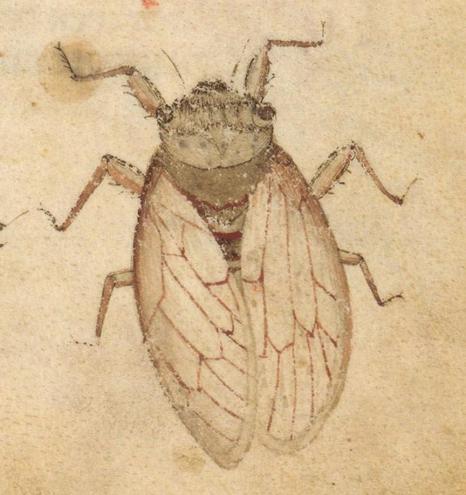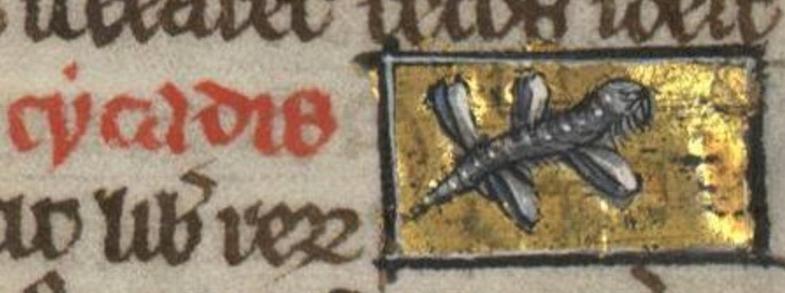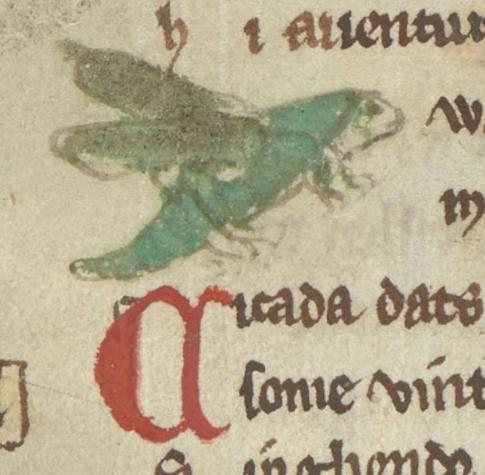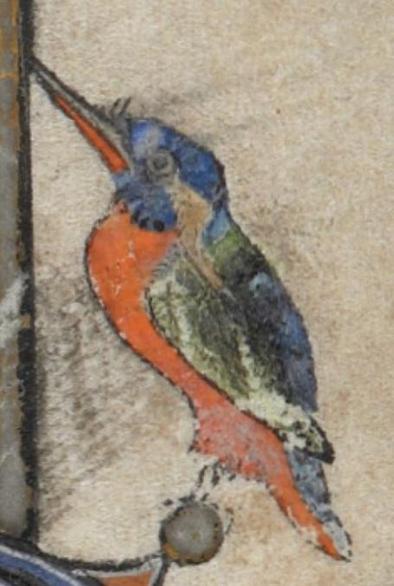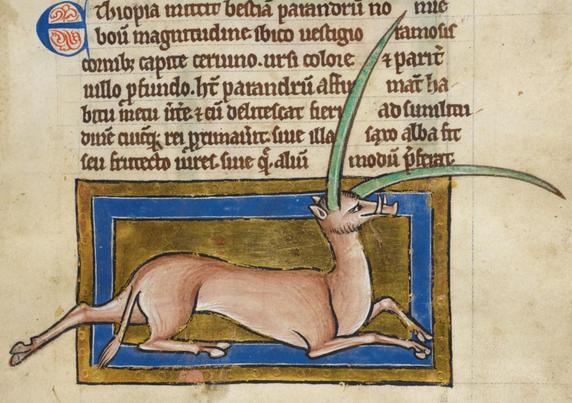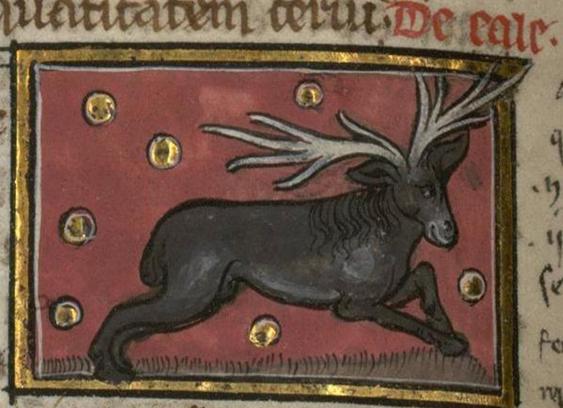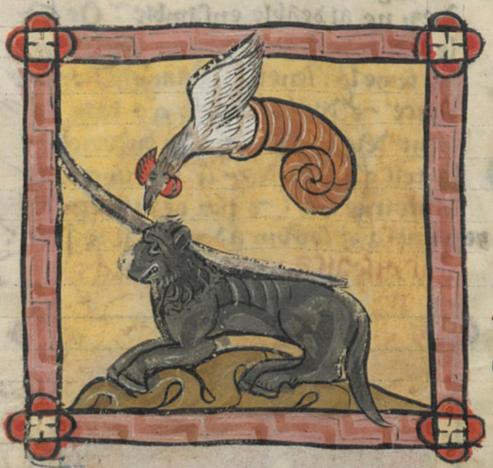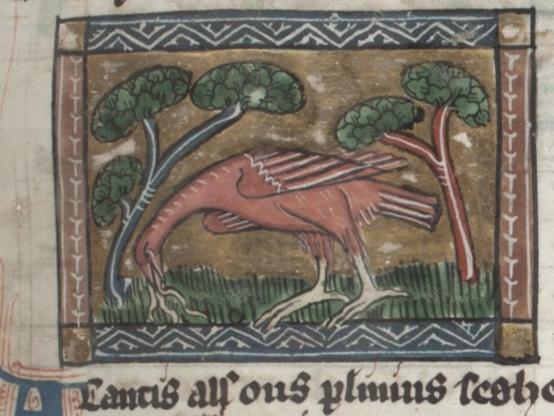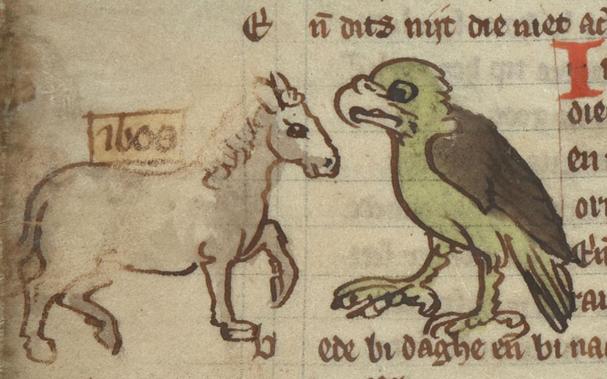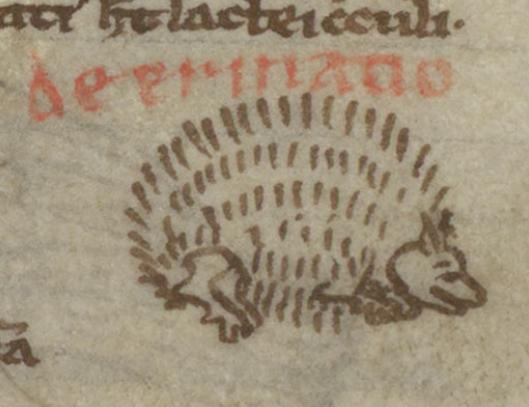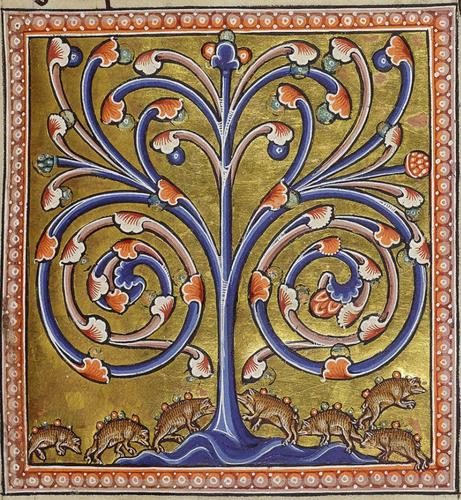Our final medieval cicada is remarkable for actually looking like a cicada even to the fine hairs on the legs. It is from an early manuscript of 'L'Acerba etas' by Cecco d'Ascoli (1257-1327). #medievalmanuscripts #medievalbeasts #beasts #cicada #cicadas
#medievalmanuscripts
Many medieval cicadas are only vaguely insect-like. This odd little beastie is from a 13th century French version of "Liber de natura rerum". It seems to have the prickles on its underside with which it was thought to absorb its food. #medievalmanuscripts #medievalbeasts #beasts #cicada #cicadas
This little green cicada is from a c1300-1325 version of "Der Naturen Bloeme" by Jacob van Maerlant (c1200-c1272). It seems to have a mouth which may explain its anxious expression as medieval cicadas were said to lack mouths . #medievalmanuscripts #medievalbeasts #beasts #cicada #cicadas
Our medieval beast this week is the cicada which was thought to be born from a cuckoo's saliva. This image of five cicadas is from a 1447 French translation of "De proprietatibus rerum" by Bartholomeus Anglicus (1203-1272). #medievalmanuscripts #medievalbeasts #beasts #cicada #cicadas
Exhibition Room prepared for decanting. Installation, necessarily, takes ages. Decanting is fairly swift, even when purposely working slow.
Vitrines covered, boxes in place, keys ready, steps available, radio tuned and playing.
Seven cases, approximately 30 items, took two of us about an hour.
Next steps include condition checks, light exposure analysis and recording.
Next installation will start January 2026.
#CollectionCare
#Exhibitions
#MedievalManuscripts
#IlluminatedManuscripts
New instance, new #introduction
#BookConservation
#PaperConservation
Heritage #EnvironmentalMonitoring
#Exhibitions
#MedievalManuscripts
#GLAM
#Naps
#Reading
#Travel
#Introvert
#Cake
Masking in public. Public transport over car driving with acknowledgement that some people need a car. Twitter alumni from the early exodus. Love heist films. American and English languages with a few other basics under the tongue: Italian, Spanish, Swahili, Japanese. Best trip ever was Antarctica.
This particular medieval kingfisher is surprising in that it actually looks like a kingfisher as we know it, even to the colours. It is from the Alphonso Psalter, dated to 1284. #medievalbeasts #medievalmanuscripts #kingfisher #kingfishers
This delightfully cross-looking medieval kingfisher giving the viewer the side-eye as it stomps across the page is from Ann Walsh's Bestiary (dated 1400-1425) which is known for its whimsical drawings. #medievalbeasts #medievalmanuscripts #kingfisher #kingfishers
It looks more like a pelican to me. #medievalbeasts #medievalmanuscripts #kingfisher #kingfishers
This week's medieval beast is the kingfisher which may (or may not) be the same as the modern bird of the same name. It is commonly shown reaching back to its own tail feathers as in this image from the Aberdeen Bestiary (c1200). #medievalbeasts #medievalmanuscripts #kingfisher #kingfishers
This may be my favourite illustration of the yale, although its colour doesn't match the "black" of the description. I love the way its exaggerated horns actually appear to be moving and its dainty pose. It is from a British bestiary dated to c1200-1210. #medievalbeasts #medievalmanuscripts #yale
This medieval yale has an unusual set of horns in that they are branched like antlers, although they are still pointing in different directions. It is from an encyclopaedia written by Thomas de Cantimpré (1201-1272) around 1240. #medievalbeasts #medievalmanuscripts #yale
The medieval yale was also described as being black and its only known enemy was the basilisk as shown in this image from a bestiary by Pierre de Beauvais dated to the 13th century. #medievalbeasts #medievalmanuscripts #yale
in case anybody was wondering where these weird little guys came from:
LeafPup Creature: The Northern French Hebrew Miscellany, BL Add 11639, f68v
UniCreature: The Maastricht Hours, BL Stowe MS 17, f219r
Flower Creature: The Hours of Saint-Omer (first half), BL Add 36684
MerBunny: The Book of Hours, use of Metz, Metz. BM, MS 1588, f148r
#medieval #marginalia #medievalManuscripts #medievalMarginalia
Our fourth different medieval anthus is again from a 1287 edition of "Der Naturen Bloeme". All the images I have been able to find of the anthus have been from "Der Naturen Bloeme" or "Liber de natura rerum". #medievalbeasts #medievalmanuscripts #anthus
The medieval anthus was said to eat grass which was the reason it was in such conflict with the horse. This anthus is yet another style of bird. It dates from 1350 and is from another edition of "Der Naturen Bloeme" by Jacob van Maerlant (c1235-c1291). #medievalbeasts #medievalmanuscripts #anthus
This particular anthus from an early 14th century manuscript of "Der Naturen Bloeme" looks like a parrot highlighting the extreme vagueness of the bird's description in medieval manuscript. #medievalbeasts #medievalmanuscripts #anthus
Our medieval creature this week is the anthus. It is described as a small bird which fought horses as in this 13th century illustration from "Liber de natura rerum" by Thomas de Cantimpré (1201-c1272). #medievalbeasts #medievalmanuscripts #thomasdecantimpré #anthus
Our oldest medieval hedgehog (from the last half of the 12th century) is also one of our more realistic. I love how this little beast looks like it has been sketched hurriedly by the scribe. #medievalmanuscripts #medievalbeasts #hedgehog #hedgehogs
Although often shown very realistically, the medieval hedgehog was also shown in a more imaginative light as this image of what looks like spiky piglets from the Aberdeen Bestiary (c1200). #medievalmanuscripts #medievalbeasts #hedgehog #hedgehogs #aberdeenbestiary
